Back
A day trip to Sravanabelagola, Belur, and
Halebid
On the second Sunday we were in Bangalore,
we hired a car and driver and set off at 6:30 a.m. for an all day trip
to several temples far west of Bangalore. Guiding us on the trip was Ravindra,
a young HISO computer engineer. We pulled off the road at 8:00 a.m.
for breakfast of vada and idlli and tea in a funky roadside
cafe. We stopped again in Hassan for a quick set of fresh lime
sodas before arriving at Belur at about 11:00 a.m. We left our shoes in
the taxi since everyone who enters a temple complex must be barefoot.
The exterior of the tall gate was grander than the temple, though the interior
of the Belur temple was the real star.
(Click on each
photo for an enlarged picture. Click "Back" to return to this page.)
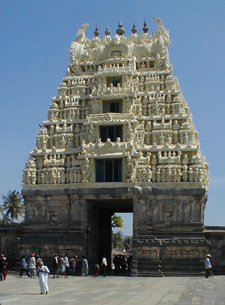
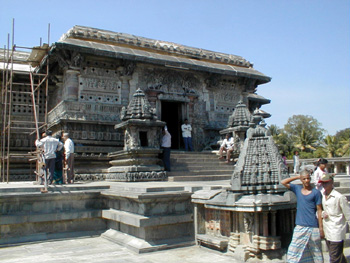
The inner courtyard at Belur boasts
a 800-year-old temple, and the interior was filled with dozens of marvellous
pillars, each a unique design carved in soapstone. We observed the rituals
of Hindu worship, peering into a dark inner sactum which was active with
priests making offerings. They periodically brought sacraments of
fire and water out for the visiting worshippers.
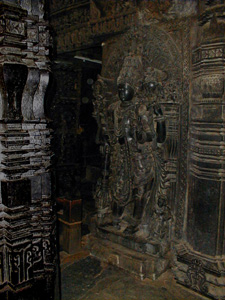
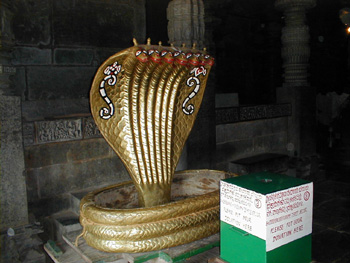
We reached the next stop, Halebid,
driving fast over a single lane road that badly needed repair (as did the
springs and shocks in our driver's Ambassador). We were grateful
just to get out of the car, but we were even more pleased to see Halebid.
Built along the basic design of the temple we had just seen at Belur and
of similar antiquity, the outside of the temple at Halebid was more richly
decorated with carvings and imagery. Part of the temple complex included
not one but two six- foot-high stone statues of Nandi (the vehicle of choice
of the god Shiva), though they were not as large as the amazing Nandi statues
at the Bull Temple in Bangalore or on Chamundi Hill above Mysore.
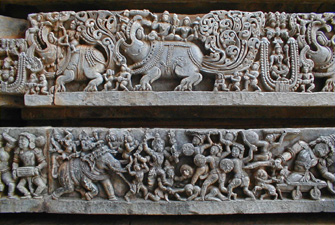
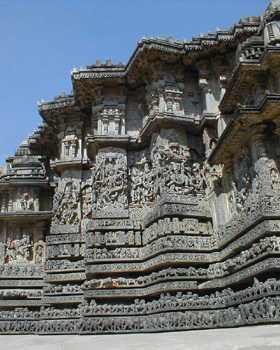
The highlight and literally the high
point of the day was the visit to the town of Srvanabelagola, site of a
major temple of the Jain faith. Jainism is a major religion in India,
closely related to Hinduism but with the special committment to non-violence,
renunciation, and a reverence to all living things. The Jain temple at
Srvanabelagola displayed different idols than other Hindu temples we saw,
mostly filled with statues of saints known as tirthankars.
Perched high atop a granite hill,
and reached only by climbing barefoot up 900 stone steps, the statue of
Bahubali stands 56 feet tall and is carved from the same rock that it stands
on. Dating back over 1000 years, the statue represents the son of
the first tirthankar, Adinath, who renounced all material possessions
(including his clothes!) and meditated in the forest for 12 years.
So long and deep was his meditation that anthills grew around him and vines
became entwined around his arms and legs, all plainly visible on the statue.
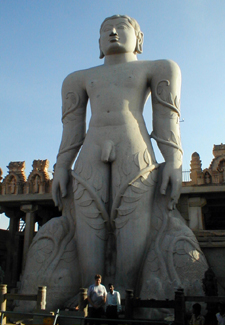
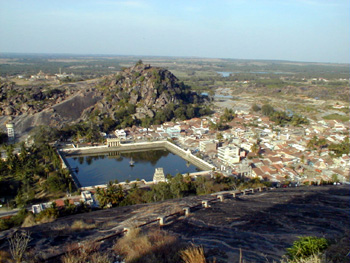
Once every 12 years, Srvanabelagola
is the scene of a weeklong festival attended by many thousands of devotees,
when the faithful pay handsomely for the right to anoint the statue with
thousands of buckets of all manner of liquids--ghee (clarified butter),
yogurt, milk, coconut juice, bananas, etc. In contrast to that madcap event,
the crowds in the city were light during our visit there, and the temple
itself was relatively calm.
Because our HISO guide practiced
the Jain faith, we managed a special visit with the head priest of the
Srvanabelagola temple. As you might expect, the priest was a very
calm and ardent proponent of Jainism, and he told us about the positive
influence that one finds with the renunciation of worldly things.
I was glad to hear that the funds collected from the worshippers are put
to use in the local village for medicine and medical treatment such as
an eye clinic.
The end of the day was not unexciting,
for we had to drive back to Bangalore in the dark, watching in shock as
the driver dodged all manner of cows, bulls, bicycles, trucks, and busses
on the road (many with their lights turned off!). I've learned since that
this was par for the course. Arriving back in Bangalore about 9:00 p.m,
we vowed to arrange a simpler itinerary next time, though it would be hard
to say what we would have excluded from this day. You could exclude
the transportation bit, but then you'll never leave home!







